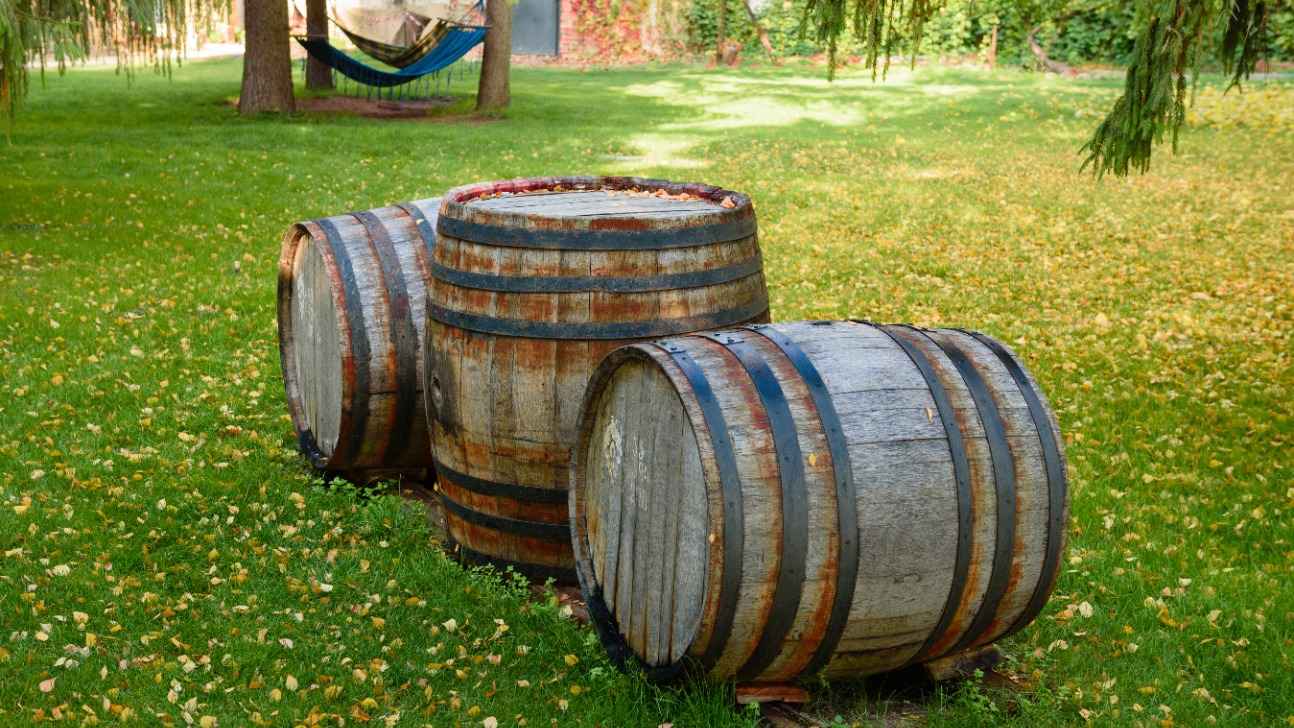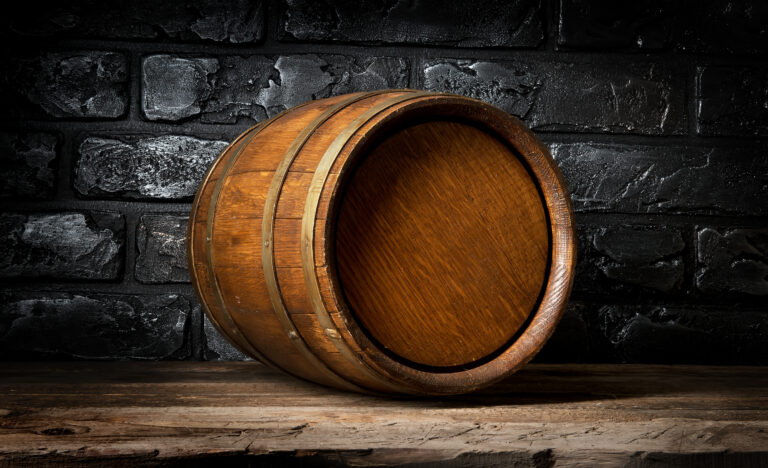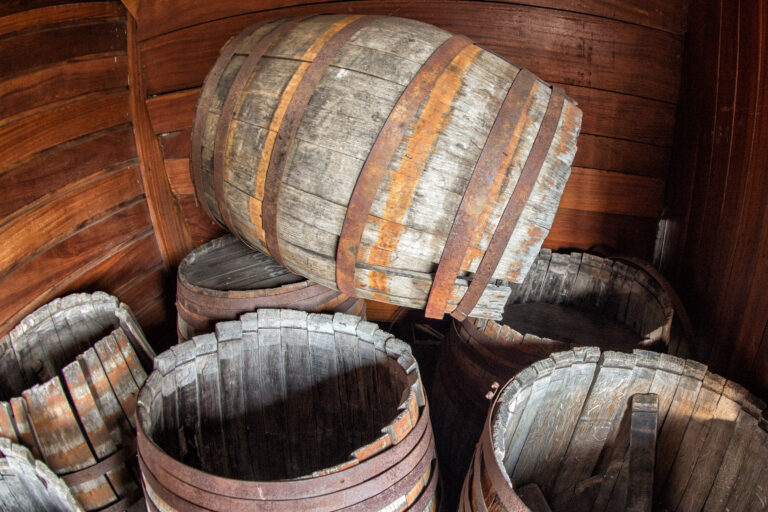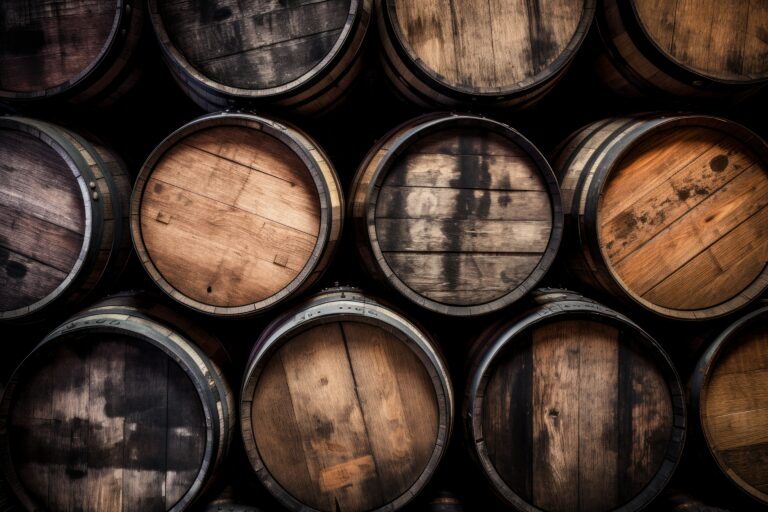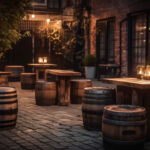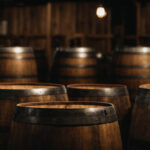That old whiskey barrel in your garage might be adding a certain “dive bar” charm, but the musty smell? Not so much. Before you banish it to the backyard, consider this: freshening up an old barrel is easier than you might think. It doesn’t require any fancy equipment or dangerous chemicals. With a few simple supplies and a bit of effort, you can have that barrel smelling oaky fresh again, ready for a new purpose – whether that’s aging another batch of whiskey or becoming a unique piece of furniture.
Why Whiskey Barrels Get Musty: Understanding the Science of Smell
Whiskey barrels, those oaky vessels that give our favorite spirit its character, can sometimes develop unpleasant odors. This happens due to a complex interplay of factors:
Oxidation: The Unseen Culprit
As whiskey ages inside a barrel, the wood expands and contracts with changes in temperature. This allows oxygen to seep into the barrel and interact with the whiskey. This process, known as oxidation, is responsible for many of the desirable flavor changes that occur during aging. However, it can also create volatile sulfur compounds, like dimethyl trisulfide, which has a distinct rotten egg smell. Older barrels, with their more porous wood, are especially susceptible to oxidation and the development of these off-putting odors.
The Ghost of Spirits Past
Barrels often have a history before they arrive at a distillery. They might have been used to age other spirits like wine, sherry, or port. These previous contents can leave behind lingering aromas that mingle with the whiskey, creating a complex and sometimes unpleasant olfactory experience. Imagine a barrel that once held a rich, fruity port now being used to age a delicate, floral whiskey – the clash of aromas could be quite jarring.
Mold and Bacteria: Uninvited Guests
If a barrel isn’t cleaned and dried properly after its contents are emptied, leftover whiskey residue can become a breeding ground for mold and bacteria. These microorganisms thrive in the damp, dark environment inside the barrel, producing musty, earthy smells that can penetrate deep into the wood. This is why proper barrel hygiene is crucial to prevent unwanted odors and ensure the quality of the whiskey.
Types of Smells and How to Tackle Them: A Sensory Guide
When assessing your whiskey barrel, you might encounter a few different types of odors, each with its own cause and solution:
Musty: The Scent of Neglect
This damp, earthy smell is a telltale sign of mold or mildew. It often occurs in barrels stored in humid environments without proper ventilation. To banish the musty odor, start by wiping down the inside of the barrel with a mold-killing primer. This will eliminate any existing mold and prevent future growth. Then, allow the barrel to air out completely for several days, preferably in a sunny location. The combination of fresh air and sunlight will help to naturally deodorize the wood.
Sour: A Sign of Bacterial Activity
A vinegar-like smell indicates the presence of bacteria, usually caused by leftover liquid trapped in the wood. To neutralize this sour odor, rinse the barrel thoroughly with a mixture of water and white vinegar or lemon juice. The acidity of these liquids will help to kill the bacteria and eliminate the smell. After rinsing, allow the barrel to air dry completely to prevent further bacterial growth.
Overly Woody: When Oakiness Overwhelms
While oakiness is a desirable characteristic in whiskey, an overpowering woody smell can mask other subtle flavors and aromas. This often happens in older barrels where the wood has been heavily exposed to the aging process. To mellow out the woody smell, scrub the inside of the barrel with an abrasive sponge or steel wool. This will help to remove some of the surface wood and the oils that contribute to the strong woody aroma. After scrubbing, rinse the barrel and allow it to air dry.
Cleaning vs. Rejuvenating: Choosing the Right Approach
You have two main options when freshening up a barrel, each with its own benefits and considerations:
Cleaning: Back to Basics
Cleaning focuses on removing built-up residue and sediment to restore the barrel to a “like-new” state. This is a good option for barrels that have developed minor odors or haven’t been used extensively. To clean a barrel, fill it with a mixture of warm water and citric acid or tartaric acid. These acids are natural cleaning agents that help to loosen stubborn deposits. Let the solution soak in the barrel for several days, then scrub the inside with a barrel brush to remove any remaining residue. Rinse the barrel thoroughly with water and allow it to dry completely before using it again.
Rejuvenating: A Fiery Transformation
Rejuvenating involves re-charring the inside of the barrel. This process adds a layer of carbonized wood that interacts with the whiskey, contributing additional flavors and aromas like vanilla, caramel, and smoke. Re-charring is a more intense process that can significantly impact the character of the whiskey aged in the barrel. It’s best suited for barrels that have lost some of their oak flavor or have developed strong, undesirable odors.
To re-char a barrel, you’ll need a blowtorch. Carefully apply the flame to the inside of the barrel, moving it evenly to create a consistent char layer. The level of char can be adjusted based on the desired flavor profile – a light char will impart subtle smoky notes, while a heavy char will create a more intense, roasted flavor. Remember that re-charring should be done with caution and proper safety equipment, including work gloves, eye protection, and a respirator mask.
Important Considerations for Re-Charring:
- Limit Re-Charring: A barrel can only be re-charred a few times (typically 2-3) before the wood becomes too thin and brittle.
- Flavor Impact: Re-charring can significantly darken the color of the whiskey and add strong smoky flavors.
- Safety First: Always re-char barrels in a well-ventilated area and use appropriate safety gear.
Home Remedies for Freshening: The Power of the Pantry
You might be surprised to learn that some of the most effective barrel fresheners can be found right in your pantry:
Baking Soda: The Odor Eater
Baking soda is a natural odor absorber that has been used for centuries to neutralize unwanted smells. To freshen up your whiskey barrel, simply pour about 1/2 cup of baking soda into the barrel and seal it tightly. Let the baking soda sit in the barrel for a week, allowing it to absorb the musty odors. Then, empty the barrel, rinse it thoroughly with water, and allow it to air dry completely.
Activated Charcoal: The Odor Trapper
Activated charcoal is another natural odor eliminator that works by trapping odor molecules within its porous structure. Place a few charcoal briquettes or activated charcoal packets in the barrel, seal it, and leave it for a week. The charcoal will effectively deodorize the wood, leaving it smelling fresh and clean. After a week, remove the charcoal, rinse the barrel, and let it air dry.
Lemon Juice: The Natural Deodorizer
Lemon juice is a natural deodorizer and disinfectant that can effectively eliminate stale smells and leave behind a refreshing citrus scent. Squeeze the juice from 3-4 lemons into the barrel, seal it, and let it sit for a week. The lemon juice will work its magic, neutralizing odors and leaving a pleasant fragrance. Rinse the barrel with water and allow it to air dry.
Vanilla Extract: The Sweet Solution
Vanilla extract, with its strong, sweet aroma, can effectively mask unpleasant odors and impart a delightful vanilla scent to the barrel. Pour 1-2 bottles of vanilla extract into the barrel, seal it, and leave it for a week. The vanilla will permeate the wood, leaving a long-lasting fragrance. Rinse the barrel with water and allow it to air dry before using it again.
White Vinegar: The Odor Neutralizer
White vinegar is another powerful odor neutralizer that can effectively eliminate musty smells and balance the pH of the wood. Pour 2-3 liters of white vinegar into the barrel, seal it, and let it sit for 1-2 weeks. The vinegar will work to deodorize the wood and leave it smelling fresh and clean. After emptying the barrel, rinse it thoroughly with water and allow it to air dry completely.
Commercial Products: When You Need Extra Help
If home remedies aren’t quite doing the trick, several commercial products can provide extra cleaning power:
OxiClean: The Stain and Odor Fighter
OxiClean is an oxygen-based stain remover that’s also effective at deodorizing and brightening barrels. To use it, make a paste of OxiClean powder and warm water, then apply it to the inside of the barrel with a scrub brush. Let the paste sit overnight to allow the oxygen to work its magic, then rinse the barrel thoroughly with water until the water runs clear.
Baking Soda: The Versatile Cleaner
Yes, the same baking soda from your pantry can also be used for a more intensive cleaning. Make a thick paste with baking soda and warm water, then scrub it into the wood with a brush. Let the paste sit for at least 12 hours, or even overnight, to allow the baking soda to neutralize and absorb odors. Rinse thoroughly when done.
Hydrogen Peroxide: The Bacteria Buster
Hydrogen peroxide is a powerful disinfectant that can kill bacteria and eliminate odors. Pour 3% hydrogen peroxide into the barrel until it’s about 1/4 full. Scrub the peroxide into the wood with a brush and let it sit for several hours or overnight. The hydrogen peroxide will release oxygen bubbles that help to lift stains and odors from the wood. Afterward, pour out the peroxide and rinse the barrel several times with water.
Commercial Barrel Cleaners: The Heavy Duty Option
For the toughest odors and residue, consider using a commercial barrel cleaner specifically formulated for whiskey barrels. These cleaners are designed to penetrate deep into the wood and remove stubborn contaminants. Follow the product instructions carefully, scrubbing the cleaner into the barrel and then rinsing and neutralizing as directed. You might need to repeat the process a few times for optimal results.
Preventing Odors During Storage: Proactive Care for Long-Term Freshness
Preventing odors in the first place is always easier than trying to eliminate them later. Here are some essential tips to keep your whiskey barrels smelling fresh during storage:
Clean and Sanitize: The Foundation of Freshness
Before storing a barrel, it’s crucial to give it a thorough cleaning. Use hot water and a barrel brush to remove any remaining residue or char particles. For stubborn odors or if the barrel was previously used to age something other than whiskey, consider using a commercial barrel cleaner or sanitizer. After cleaning, allow the barrel to dry completely. This is crucial to prevent mold growth, which can lead to musty odors.
Control Humidity: The Enemy of Freshness
Excess moisture is a major contributor to the development of unpleasant odors in whiskey barrels. It creates an ideal environment for the growth of bacteria and yeast, which can produce foul smells. To prevent this, store your barrels in a humidity-controlled environment, ideally with a relative humidity between 65% and 70%. If necessary, use a dehumidifier or air conditioner to maintain optimal humidity levels. High humidity can also cause the wood to swell, which can lead to leaks and further complicate storage.
Ventilation: The Key to Air Circulation
Proper ventilation is essential to prevent odors from concentrating inside the barrel. Stagnant air allows odor molecules to build up, creating a more potent smell. To ensure good airflow, use fans to circulate the air in the storage area. Avoid stacking barrels directly on top of each other, as this can restrict airflow and trap moisture.
Regular Inspection: The Early Detection System
Regularly inspecting your barrels is crucial to catch any potential problems early on. At least once a month, check your barrels for any signs of leaks, mold growth, or pests. These issues can contaminate the whiskey and create unpleasant odors if left unaddressed. By addressing problems promptly, you can prevent permanent damage to the barrel and ensure the quality of your whiskey.
Toasting: The Preemptive Strike
Lightly toasting used barrels before refilling them can help to sanitize the interior and eliminate stubborn odors. The heat from toasting will kill bacteria, yeasts, and other contaminants that can cause unpleasant smells. It also helps the barrel retain moisture, which is important for proper aging and flavor development. Toasting should be done carefully to avoid over-charring the wood, which can impart burnt flavors to the whiskey.
When to Retire a Barrel: Recognizing the End of the Line
Even with the best care, whiskey barrels eventually reach the end of their useful life. Recognizing when to retire a barrel is an important skill for any distiller. Here are some signs that a barrel might be past its prime:
- Flat and One-Dimensional Whiskey: If the barrel is no longer contributing the desired flavors and aromas, such as vanilla, caramel, and oak, it might be time to replace it. The whiskey might taste dull and lack complexity, indicating that the wood has little left to offer.
- Unpleasant Flavors: If you notice musty, stale, or metallic flavors in the whiskey, the barrel could be contaminated with unwanted microbes. These microbes can spoil the whiskey, making it undrinkable. In such cases, it’s best to stop using the barrel immediately.
- Excessive Leaking: While some evaporation and leakage are normal, excessive leaking indicates that the barrel is no longer able to hold liquid effectively. This can lead to significant whiskey loss and hinder the aging process.
- Warped or Cracked Staves: If the barrel staves are warped or cracked, the barrel is no longer watertight. This allows air to enter the barrel, which can spoil the whiskey.
- Multiple Uses: As a general rule of thumb, most distillers get 3 to 5 uses out of a barrel before its flavor impact diminishes significantly. After this point, the wood has little left to contribute to the whiskey.
Repurposing Old Barrels: From Distillery to Décor
Even when a barrel is no longer suitable for aging whiskey, it still has plenty of life left. Repurposing old barrels is a great way to give them a second life and add a touch of rustic charm to your home or garden.
Furniture: Rustic Charm
Barrel staves can be repurposed into beautiful and functional furniture pieces. The curved shape of the staves lends itself well to creating chairs, tables, benches, and stools. You can disassemble a barrel and use the staves for the seat, back, and legs of your furniture. Sand down any rough edges and seal the wood with polyurethane for protection and durability. Barrel hoops can also be used to create unique tabletops or serving trays.
Planters: A Green Oasis
Whiskey barrels make excellent planters, especially for larger plants like small trees, shrubs, and flowering vines. Their size and shape are perfect for container gardening on patios, porches, and decks. To use a barrel as a planter, drill a few drainage holes in the bottom, fill it with potting soil, and add your plants. For a more rustic look, consider distressing the barrel with sandpaper and a wire brush before planting.
Storage: Organized and Stylish
Barrels can be transformed into unique storage containers for a variety of items. Use them to store yard tools, sports equipment, blankets, children’s toys, or anything else you need to keep organized. You can add a personal touch by stenciling designs or labels on the outside of the barrel. Lidded barrels are ideal for storing items outdoors, as they protect the contents from the elements.
Decor: Rustic Accents
Smaller barrels, especially those cut in half, make great decorative accents around the home. Use them as end tables, side tables, or drink tables. Fill them with greenery, candles, river rocks, or seasonal items like pumpkins and pine cones. Their charming shape and rustic character add a touch of warmth and personality to any space.
FAQ: Answers to Common Whiskey Barrel Odor Questions
Here are some frequently asked questions about dealing with odors in whiskey barrels:
How do I get rid of smells in an old whiskey barrel?
There are several methods you can try, including scrubbing with baking soda and water, soaking with a vinegar solution or commercial odor remover, using a baking soda and hydrogen peroxide paste, charring the inside of the barrel (with caution!), and airing out the barrel in a well-ventilated area.
Will the smells return after I’ve cleaned and freshened the barrel?
It’s possible for odors to return, especially if the barrel is exposed to the same conditions that caused the odors initially. To prevent this, seal the barrel after cleaning with beeswax or food-grade mineral oil, store it in a dry and well-ventilated area, and avoid reusing it for aging alcohol. Regularly inspect the barrel and re-treat if any odors start to return.
Final Thoughts: The Legacy of the Barrel
Whiskey barrels are more than just containers for aging spirits. They are vessels of history, imbued with the character of the whiskey they hold and the stories of their journey. By understanding the causes of odors in whiskey barrels and learning how to properly clean, rejuvenate, and store them, you can ensure that these barrels continue to contribute to the enjoyment of fine spirits for years to come. And when a barrel has reached the end of its lifespan for aging whiskey, you can give it a new purpose, repurposing it into something beautiful and functional that will continue to bring joy for many years.
